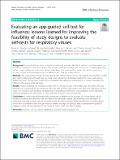Evaluating an app-guided self-test for influenza: lessons learned for improving the feasibility of study designs to evaluate self-tests for respiratory viruses
Author(s)
Zigman Suchsland, Monica L.; Rahmatullah, Ivan; Lutz, Barry; Lyon, Victoria; Huang, Shichu; Kline, Enos; Graham, Chelsey; Cooper, Shawna; Su, Philip; Smedinghoff, Sam; Chu, Helen Y.; Sewalk, Kara; Brownstein, John S.; Thompson, Matthew J.; ... Show more Show less
Download12879_2021_Article_6314.pdf (671.1Kb)
Publisher with Creative Commons License
Publisher with Creative Commons License
Creative Commons Attribution
Terms of use
Metadata
Show full item recordAbstract
Abstract
Background
Seasonal influenza leads to significant morbidity and mortality. Rapid self-tests could improve access to influenza testing in community settings. We aimed to evaluate the diagnostic accuracy of a mobile app-guided influenza rapid self-test for adults with influenza like illness (ILI), and identify optimal methods for conducting accuracy studies for home-based assays for influenza and other respiratory viruses.
Methods
This cross-sectional study recruited adults who self-reported ILI online. Participants downloaded a mobile app, which guided them through two low nasal swab self-samples. Participants tested the index swab using a lateral flow assay. Test accuracy results were compared to the reference swab tested in a research laboratory for influenza A/B using a molecular assay.
Results
Analysis included 739 participants, 80% were 25–64 years of age, 79% female, and 73% white. Influenza positivity was 5.9% based on the laboratory reference test. Of those who started their test, 92% reported a self-test result. The sensitivity and specificity of participants’ interpretation of the test result compared to the laboratory reference standard were 14% (95%CI 5–28%) and 90% (95%CI 87–92%), respectively.
Conclusions
A mobile app facilitated study procedures to determine the accuracy of a home based test for influenza, however, test sensitivity was low. Recruiting individuals outside clinical settings who self-report ILI symptoms may lead to lower rates of influenza and/or less severe disease. Earlier identification of study subjects within 48 h of symptom onset through inclusion criteria and rapid shipping of tests or pre-positioning tests is needed to allow self-testing earlier in the course of illness, when viral load is higher.
Date issued
2021-06-29Department
Massachusetts Institute of Technology. Center for Transportation & LogisticsPublisher
BioMed Central
Citation
BMC Infectious Diseases. 2021 Jun 29;21(1):617
Version: Final published version